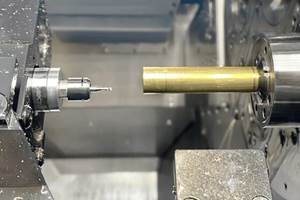Making CNC Turning Easier
For those familiar only with manual lathes, making the jump to CNC can be a scary proposition. But take heart, because more and more control builders are focusing on providing CNCs with operational and programming capabilities that even the complete novice can grasp.
Share




A good example is the new 8050TC lathe CNC from Fagor Automation (Elk Grove Village, Illinois). The aim of the new design, says the builder, is to offer lathe users a CNC as simple to operate as a DRO. The new CNC offers an easy and intuitive interface, eliminating the need for a lengthy training period in order to be able to program a part.
The interface is based on the most common operations performed on a lathe—turning, facing, threading and so on. Each one of these operations is selected via a specific key and it is designed in such a way that all the operator has to do is enter the machining conditions and part geometry data, which can be obtained directly off of a typical part print.
This sort of control makes sense in a number of typical manufacturing applications. For example, prototype manufacturers are often presented with relatively complicated parts, but that are made in very small quantities, perhaps only one. An easily programmable CNC can handle complicated geometry that's difficult to cut manually, and also keep quantity-of-one jobs out of the CAM department.
Moreover, many companies with operators who are skilled in machining, but not programming, need an easy-to-use CNC in order to save on machine setup time. With them in mind, an interface has been developed which allows operators to enter part geometry the way it appears on a print, without having to use any programming language. All that has to be done is enter the operations required to make the part (turning, facing, and so on) sequentially and with the proper coordinates. All these operations may then be graphically verified on the CNC monitor before finishing the part program.
For longer run manufacturers, the CNC offers an advanced profile editor (capable of solving part geometry with undefined coordinates, tangency, and so on) or the choice of using ISO and high-level language programming.
The CNC spans an operational range from emulation of a manual lathe to full production turning. In jog mode the control shows the basic process information including position of the axes, feed rate, spindle rpm and selected tool. In this mode, the operator may perform simple machining operations in a conventional way by means of electronic handwheels. Selected tools are indicated by icons on the screen that show the shape of the tool to help avoiding accidental errors.
The CNC also offers simple control of spindle speed, turning direction and orientation. It includes operation at constant surface speed, operation with live tools, operation with jog keys (to move the axes manually) and operation with handwheels.
It also offers a number of tool management features. To establish tool offsets, the operator just has to secure the part, enter its dimensions and touch it with the tool. Then the CNC automatically collects all the necessary data to run without errors. And there is graphic assistance to enter tool geometry.
Automatic cycles are designed to better adapt to the usual working methods of a shop. The machining process is divided into a certain number of operations represented by icon keys with LEDs to indicate whether they are activated or not.
The CNC offers quite a wide variety of automatic cycles including turning, facing, rounding, taper cutting, threading, grooving, drilling and face tapping. Each one of these cycles may be simulated by using the graphics key on the operator panel in order to verify that it will run properly.
Also, profiling cycles offer several levels, depending on the complexity of the part. In Cycle 1, to enter the shape of the part, all one has to do is know the locations of its theoretical corners (up to a maximum of 12 points) and enter the desired corresponding radius or chamfer conditions. In Cycle 2, it is possible to "tell" the CNC to solve the undefined variables that come up—for instance, tangency. The program editor searches and calculates, in a totally transparent way to the user, the possible solutions according to the known data, thus eliminating the need for additional manual calculations. MMS
Related Content
Okuma Demonstrates Different Perspectives on Automation
Several machine tools featured at Okuma’s 2023 Technology Showcase included different forms automation, from robots to gantry loaders to pallet changers.
Read MoreInverting Turning and Five-Axis Milling at Famar
Automation is only the tip of the iceberg for Famar, which also provides multitasking options for its vertical lathes and horizontal five-axis machine tools.
Read MoreInside the Premium Machine Shop Making Fasteners
AMPG can’t help but take risks — its management doesn’t know how to run machines. But these risks have enabled it to become a runaway success in its market.
Read More3 Tips to Accelerate Production on Swiss Lathes with Micro Tools
Low RPM lathes can cause tool breakage and prevent you from achieving proper SFM, but live tooling can provide an economical solution for these problems that can accelerate production.
Read MoreRead Next
Setting Up the Building Blocks for a Digital Factory
Woodward Inc. spent over a year developing an API to connect machines to its digital factory. Caron Engineering’s MiConnect has cut most of this process while also granting the shop greater access to machine information.
Read MoreRegistration Now Open for the Precision Machining Technology Show (PMTS) 2025
The precision machining industry’s premier event returns to Cleveland, OH, April 1-3.
Read More5 Rules of Thumb for Buying CNC Machine Tools
Use these tips to carefully plan your machine tool purchases and to avoid regretting your decision later.
Read More





















.jpg;maxWidth=300;quality=90)








.jpg;maxWidth=970;quality=90)